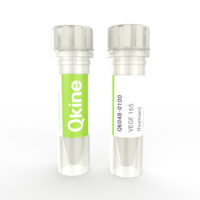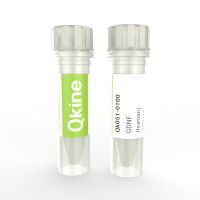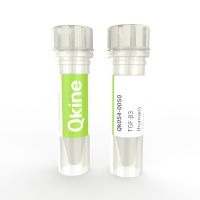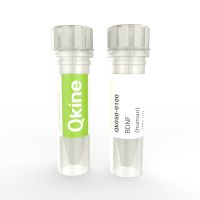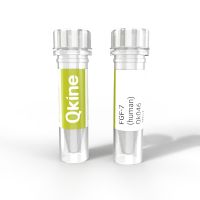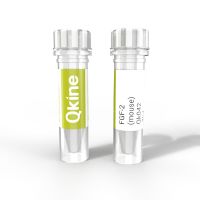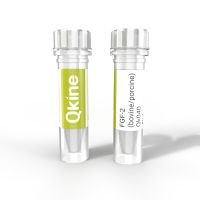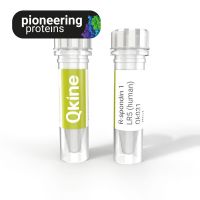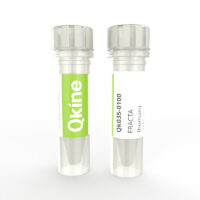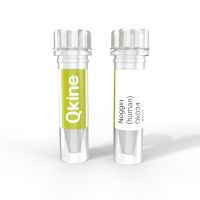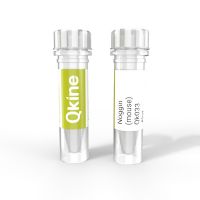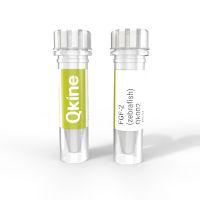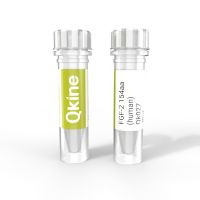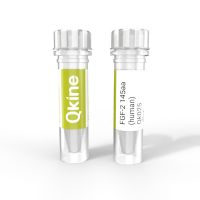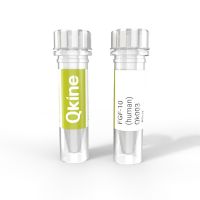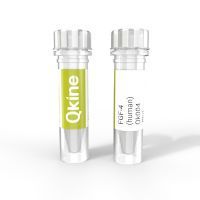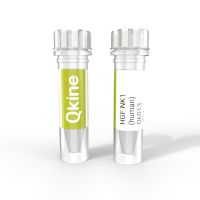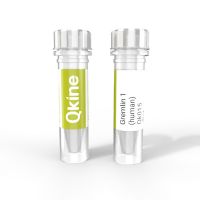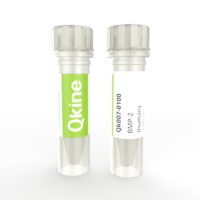- Recombinant human vascular endothelial growth factor 165 (also known as VEGF165/ VEGF-165/ VEGF-A/ VEGF165) protein is widely used in culturing primary endothelial cells, such as human umbilical vein endothelial cells.VEGF165 is commonly used with human-induced pluripotent stem cells or embryonic stem cells-derived endothelial cells for developing human vascular tissue models. It has many applications including its use in neural research involving oligodendrocyte precursor cells, Schwann cells, astrocytes, and microglia. It plays a role in bone formation, regulates mesenchymal stem cell differentiation, and serves as a survival factor for chondrocytes, hematopoietic stem cells, and tumor cells.Qkine recombinant human VEGF165 protein is a highly pure and potent 38 kDa homodimer, disulfide-linked consisting of two 165 amino acid polypeptide chains. It is an animal origin free (AOF) and carrier protein-free (CF) isoform of VEGF for high efficiency.
- Glial cell line-derived neurotrophic factor (GDNF) is a member of neurotrophin family and GDNF family of ligands (GFL). GDNF plays a crucial role in the development, growth, and survival of neurons in particular midbrain dopaminergic neurons. It promotes the axon growth and innervation of dopamine neurons. GNDF is used to maintain neurons and cortical organoids and to differentiate dopaminergic neurons from human pluripotent stem cell-derived neural progenitors. GDNF also facilitates the differentiation of neural progenitors to astrocytes.Recombinant human GDNF bioactive 30 kDa homodimer. This protein is animal-free (AOF), carrier protein-free, and tag-free to ensure its purity with exceptional lot-to-lot consistency. Qk051 is suitable for the culture of reproducible and high-quality cortical and motor neurons and cortical organoids.
- Human TGF-β3 protein is a member of the Transforming Growth Factor family, a family involved in regulating cell survival, proliferation and differentiation.1 TGF-β3 is used in human pluripotent stem cell maintenance medias, such as B8 media.2 High purity and bioactivity for reproducible results. Human TGF-β3 protein dimer, animal-origin free (AOF) and carrier-protein free (CF).
- Brain-derived neurotrophic factor (BDNF) is a member of neurotrophin family and plays a crucial role in neural development, maintenance, and function. It stimulates neurogenesis and is also a major regulator of synaptic plasticity and neuroprotection. It is used to maintain neurons and differentiate and mature human pluripotent stem cell-derived neural progenitors to cortical and motor neurons and cortical organoids.Recombinant human BDNF protein has a molecular weight of 14 kDa. This protein is animal-free, carrier-free, tag-free, and non-glycosylated to ensure its purity with exceptional lot-to-lot consistency. Qk050 is suitable for the culture of reproducible and high-quality cortical and motor neurons and cortical organoids.
- Human KGF protein (FGF-7) is a member of the FGF family secreted by mesenchymal cells and has a paracrine effect on neighbouring epithelial cells.1 KGF protein is used in the culture of lung, breast, liver, and bladder organoids.2 In vivo, KGF is involved in wound healing and development of kidney, thymus, and hippocampus.1High purity and bioactivity 19 kDa human FGF-7 / KGF protein, animal-origin free (AOF) and carrier-protein free (CF).
- Recombinant mouse FGF2 protein/ bFGF is an important factor in the maintenance of mouse epiblast-derived stem cells (EpiSC). Mouse naïve pluripotency is maintained by LIF, BMP4, and Wnt signalling pathways. However, the primed state of pluripotency in mouse EpiSCs is more similar to hESC and hiPSC, being maintained by FGF2 and TGFβ/Activin/Nodal pathways.1,2High purity and bioactivity 16 kDa murine bFGF / FGF2 (basic FGF) protein, animal-origin free (AOF) and carrier-protein free (CF).
- Recombinant bovine/porcine FGF2 protein 145 aa (bFGF/basic FGF) for the development of species-specific bovine (cow) and porcine (pig) cellular agriculture protocols and veterinary research applications. Used in comparative cell culture media optimization studies alongside Qk056, the 154aa form of porcine/bovine FGF-2.FGF-2 is used extensively in the maintenance and proliferation of induced pluripotent (iPSC) and embryonic stem cells (ESC)1-3 and for enhancement of proliferation in primary cell culture.High purity 16 kDa FGF-2 / bFGF protein, animal origin-free (AOF) and carrier-protein free (CF).
- Recombinant human r-spondin 1 LR5 protein is engineered to act as a high affinity ligand for the LGR5 receptor. In epithelial tissues LGR5 marks the stem cell population. This engineered protein, R-spondin 1 LR5, activates wnt signalling only in the LGR5+ stem cell population. R-spondin1 LR5 has been tested in intestinal organoid culture and supports organoid survival and growth. As LGR5 specifically marks stem cells and is not found on transit amplifying cells, the lower crypt multiplicity seen in organoid cultures with R-spondin 1 LR5 (in comparison to wild-type R-spondin 1, Qk006) supports the notion that this engineered form is acting specifically on stem cells. This specialized form of R-spondin 1 was developed in Marc de la Roche’s lab (University of Cambridge).
- Follistatin-resistant activin A protein (FRACTA) has been engineered to prevent binding to the natural inhibitor, follistatin. Activin A activity protein is regulated in vivo by follistatin, a high-affinity inhibitor; follistatin accumulates in stem cell culture, where it inhibits activin A.Qk035 follistatin-resistant activin A protein (FRACTA) has equivalent bioactivity to wild-type activin A (Qk001) but does not bind follistatin so is resistant to feedback inhibition. High purity 26 kDa dimer comprising engineered mature domain of activin A protein, animal-free (AF) and carrier-protein free (CF). This specialised activin A has been developed in Marko Hyvönen’s group in the University of Cambridge.
- Human noggin is a bone morphogenetic protein (BMP) family antagonist used in the culture of intestinal, pancreatic, lung and tumor-derived organoids, maintenance of undifferentiated embryonic stem cells and for stem cell differentiation into neural and microglial lineages.Qkine human noggin protein is a highly pure 46kDa bioactive dimer for reproducible results in organoid culture.
- Mouse/rat noggin is a bone morphogenetic protein (BMP) family antagonist used in the culture of intestinal, pancreatic, lung and tumor-derived organoids, maintenance of undifferentiated embryonic stem cells and for stem cell differentiation into neural and microglial lineages.Qkine recombinant mouse noggin protein is a highly pure 46kDa bioactive dimer for reproducible results (animal-free and carrier-protein free).
- Zebrafish FGF-2 protein (bFGF/basic FGF) has been used extensively to support the maintenance and proliferation of human and mouse induced pluripotent (iPSC) and embryonic stem cells (ESC); used in the original Ludwig et al feeder-free culture of embryonic stem cells protocols 1-3. High purity 17 kDa FGF2 / bFGF protein, animal-derived component free (ACDF) and carrier-protein free (CF). This version of recombinant zebrafish FGF2 is used by the core facility at the Cambridge Stem Cell Institute, UK and historically by many of the stem cell groups based at University of Cambridge.
- Recombinant human FGF2 protein (154 aa) is a highly bioactive, long–form of human fibroblast growth factor 2 protein. FGF-2 protein is used to support the maintenance of human embryonic stem cells and proliferation and differentiation of induced pluripotent and mesenchymal stem cells. This 154 aa form of FGF-2 comprises the core structured region and N-terminal extension.High purity and bioactivity 17 kDa FGF-2 / bFGF protein, animal-free (AOF) and carrier-protein free (CF).
- Human FGF2 /bFGF protein (145 aa) is our gold-standard and recommended FGF2 / bFGF protein for induced pluripotent stem cell (iPSC) and embryonic stem cells (ESC) maintenance, and induced pluripotent and mesenchymal stem cells proliferation and differentiation.High purity and bioactivity 17 kDa FGF2 / bFGF protein, animal-derived component free (ACDF) and carrier-protein free (CF) comprising the core structured region (145 amino acids) sufficient for full biological activity.
- Human/rat/porcine/bovine FGF10 protein promotes lung organoid formation and induces branching morphology. FGF10 protein is used widely in organoid culture, embryonic stem cell (ESC) and induced-pluripotent stem cell (iPSC) differentiation, and for the study of epithelial to mesenchymal transition and tumor metastasis.High purity and bioactivity 17 kDa, bioactive domain of human fibroblast growth factor 10, animal-free (AOF) and carrier-protein free (CF).
- Human FGF-4 protein is used for the proliferation and differentiation of embryonic and induced-pluripotent and tissue (mesenchymal) stem cells and promotes neural stem cell proliferation. FGF-4 is an important component of cardiac, intestinal and other organoid culture media.High purity and bioactivity 14 kDa, bioactive domain of human fibroblast growth factor 4, animal origin free (AOF) and carrier-protein free.
- Hepatocyte growth factor (HGF) is a multi-functional cytokine that promotes the growth and proliferation of various cell types including mesenchymal, endothelial, and epithelial cells. It is involved in embryonic development, cell motility, survival, angiogenesis, and tissue regeneration. In cell culture, HGF is used to promote the differentiation of mesenchymal cells towards hepatocytes, osteocytes, and endothelial cells. Recombinant human HFG NK1 protein is a potent naturally occurring isoform of HGF. This protein is animal-free, carrier protein-free, and tag-free to ensure its purity with exceptional lot-to-lot consistency with a molecular weight of 20 kDa. It promotes efficient differentiation of human induced pluripotent stem cells to hepatocyte-like cells at just 10 ng/ml with highly homogeneous expression of the hepatic marker, HNF4α.
- Human/bovine/porcine Gremlin 1 protein is a BMP-inhibitor present in the natural intestinal niche and provides an alternative to Noggin for optimisation of intestinal organoid culture and iPSC differentiation.Qk015 has been optimized by our experts for exceptionally high-purity production in E.coli and bioactivity. 18 kDa high purity dimeric protein, animal-free and carrier protein free
- Human EGF protein is a potent EGF-family growth factor used in many human and mouse organoid and stem cell culture systems including intestinal and tumor (cancer) organoid culture.A pure 6.3 kDa biologically active mature human epidermal growth factor. Our recombinant EGF protein is manufactured to the highest purity in E. coli and extensively tested, making it ideal for use in chemically defined iPSC, ESC and organoid culture media.
- Human/mouse/rat/bovine/porcine BMP-2 protein (bone morphogenetic protein 2) protein is member of the TGFβ family and a key regulator of embryogenesis and potent differentiation factor of embryonic stem cells (ESC) and induced pluripotent stem cells (iPSC) towards endoderm fates. BMP-2 plays roles in the differentiation of mesenchymal cells to adipocytes, epithelial cancer EMT, chondrogenesis and regulation of neuronal and glial cell development.26 kDa disulfide–linked bioactive highly pure dimer comprised of the mature domain of human BMP-2 protein. Animal-free (AOF) and carrier protein-free.
